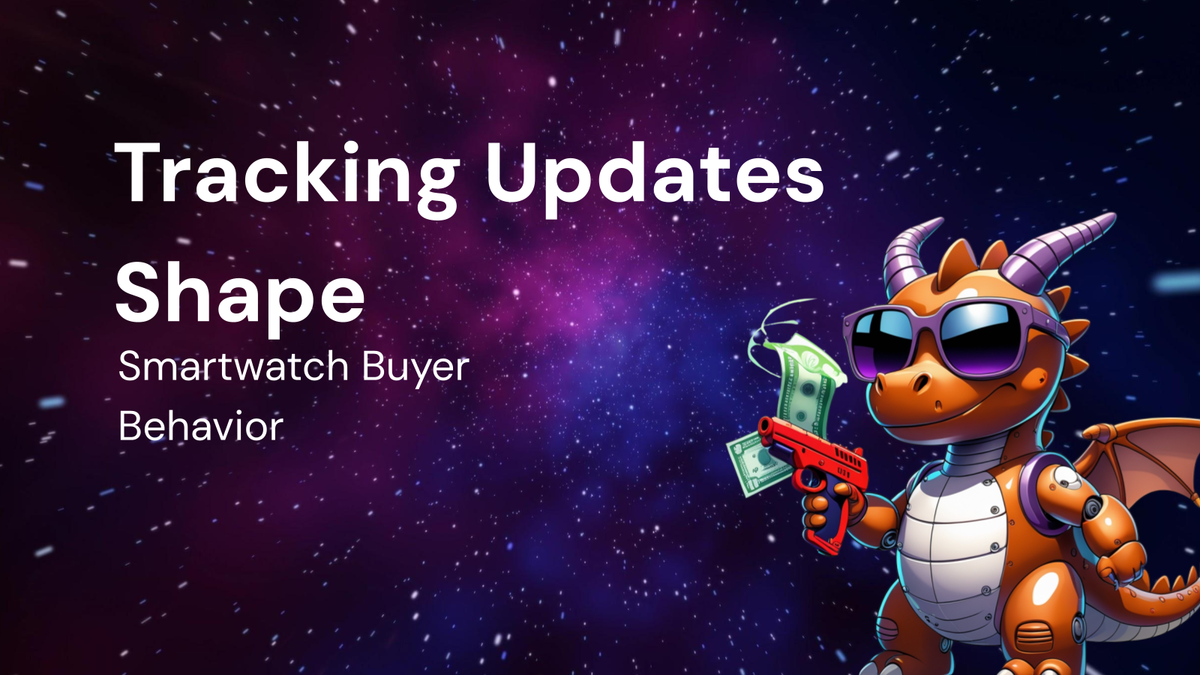How Tracking Updates Shapes Smartwatch Buyer Behavior

How Tracking Updates Shape Smartwatch Buyer Behavior
Smartwatches have evolved from simple timekeepers to sophisticated extensions of our smartphones, packed with features designed to enhance our lives. Among the most impactful of these features are the diverse tracking capabilities that monitor everything from our steps and heart rate to sleep patterns and even stress levels. These tracking updates, and how manufacturers continuously improve and promote them, play a crucial role in shaping smartwatch buyer behavior. Understanding this influence is essential for both consumers navigating the market and manufacturers striving to create successful products.
The Rise of Tracking: A Shift in Consumer Expectations
The initial appeal of smartwatches rested on their convenience – notifications on the wrist, easy access to calls and texts, and mobile payments. However, the integration of fitness and health tracking capabilities propelled the smartwatch into a new realm of functionality and appeal. This evolution coincided with a growing societal awareness of personal health and wellness, driven by readily available information and a desire for proactive health management.
Early fitness trackers, like Fitbit, paved the way by popularizing the concept of quantifying daily activity and motivating users to achieve their fitness goals. Smartwatches then incorporated and expanded upon these features, offering a more comprehensive and integrated approach to personal monitoring. Now, consumers expect a certain level of tracking capability as a standard feature in any modern smartwatch. This expectation is driven by several factors:
- Increased Health Awareness: People are more conscious of their health and well-being than ever before. Tracking features provide valuable insights into their current health status and potential areas for improvement.
- Data-Driven Motivation: The quantified self movement has shown that tracking progress, even in small increments, can be a powerful motivator for achieving personal goals. Seeing data displayed on the wrist provides immediate feedback and encourages continued effort.
- Accessibility and Convenience: Smartwatches offer a convenient and unobtrusive way to track various metrics throughout the day without requiring dedicated devices or manual recording.
- Integration with Ecosystems: The ability to sync data with other health and fitness apps, share progress with friends, and participate in challenges creates a sense of community and enhances the overall experience.
Specific Tracking Features and Their Influence on Buyer Decisions
The specific tracking features offered by a smartwatch and how they are presented to consumers significantly influence purchase decisions. Here's a breakdown of some key tracking functionalities and their impact:
- Step Counting and Activity Tracking: This is the most basic and universally expected tracking feature. The accuracy and reliability of step counting are paramount. Consumers are often drawn to brands known for their precise pedometers and comprehensive activity tracking algorithms that can differentiate between various activities like walking, running, swimming, and cycling. The way the data is presented – clear, visually appealing graphs and easy-to-understand summaries – is also a critical factor. Marketing campaigns often emphasize the ease with which users can monitor their daily activity levels and achieve their fitness goals.
- Heart Rate Monitoring: Real-time heart rate tracking has become a fundamental expectation. Consumers are increasingly interested in resting heart rate, heart rate variability (HRV), and heart rate zones during exercise. Accuracy is crucial, as this data is used for assessing workout intensity and identifying potential health concerns. Advanced features like irregular heart rhythm notifications (AFib detection) are a major selling point, offering peace of mind and the potential for early detection of serious health conditions. Marketing strategies often highlight the potential health benefits and the ability to proactively monitor cardiovascular health.
- Sleep Tracking: Analyzing sleep patterns, including sleep stages (deep sleep, light sleep, REM sleep, and awake time), has become increasingly popular. Consumers are interested in understanding the quality of their sleep and identifying factors that may be affecting it. Smartwatches that provide detailed sleep analysis, personalized insights, and recommendations for improving sleep hygiene are highly sought after. The ability to track sleep duration, consistency, and efficiency contributes to the overall appeal. Marketing materials often emphasize the importance of sleep for overall health and well-being and showcase how the smartwatch can help users optimize their sleep patterns.
- GPS Tracking: For runners, cyclists, and outdoor enthusiasts, accurate GPS tracking is essential for recording distance, pace, and route information. Smartwatches with built-in GPS provide independence from smartphones and allow users to track their workouts without carrying additional devices. The speed and accuracy of GPS acquisition are critical factors. Marketing campaigns often highlight the smartwatch's ability to track outdoor activities with precision and provide detailed performance data.
- Blood Oxygen Saturation (SpO2) Monitoring: The ability to measure blood oxygen levels has gained significant traction, particularly during the COVID-19 pandemic. This feature provides insights into respiratory health and can be used to detect potential issues. While not intended for medical diagnosis, SpO2 monitoring can alert users to potential problems and encourage them to seek professional medical advice. Marketing strategies often highlight the potential health benefits and the ability to monitor respiratory well-being.
- Stress Tracking: Monitoring stress levels through heart rate variability and other physiological indicators is becoming increasingly common. Smartwatches can provide insights into stress patterns and offer tools and techniques for stress management, such as guided breathing exercises. The ability to track stress levels throughout the day and identify triggers can be valuable for improving mental well-being. Marketing campaigns often emphasize the importance of stress management and showcase how the smartwatch can help users cope with daily stressors.
- Menstrual Cycle Tracking: For women, menstrual cycle tracking is a valuable feature for understanding their health and predicting periods. Smartwatches can track cycle length, predict ovulation, and provide insights into symptoms. This feature promotes proactive health management and can be particularly helpful for women planning pregnancies. Marketing materials often emphasize the inclusivity and health benefits for female users.
- Fall Detection: Primarily targeted towards elderly users, fall detection features automatically detect falls and can alert emergency contacts or services. This feature provides peace of mind for both users and their families and can be life-saving in the event of a fall. Marketing campaigns often highlight the safety and security aspects of this feature.
The Impact of Software Updates and Algorithm Improvements
The value of a smartwatch's tracking features doesn't end with the initial purchase. Manufacturers continuously improve the accuracy, reliability, and functionality of these features through software updates and algorithm refinements. These updates are crucial for maintaining user satisfaction and driving future purchases.
- Enhanced Accuracy: Software updates often focus on improving the accuracy of tracking algorithms, addressing issues with step counting, heart rate monitoring, GPS tracking, and other features. Manufacturers invest heavily in research and development to refine these algorithms and ensure that they provide reliable data.
- New Features and Functionality: Software updates can also introduce new tracking features and functionalities, expanding the capabilities of the smartwatch and providing users with even more insights into their health and well-being. This could include new workout modes, advanced sleep analysis metrics, or integration with new health and fitness apps.
- Improved User Interface: Software updates can also enhance the user interface, making it easier for users to access and interpret their tracking data. Clearer visualizations, more intuitive navigation, and personalized insights can improve the overall user experience.
- Bug Fixes and Performance Enhancements: Addressing bugs and improving overall performance are essential for maintaining user satisfaction. Software updates can fix issues that affect tracking accuracy, battery life, and other aspects of the smartwatch's functionality.
The frequency and quality of software updates are a major factor in shaping consumer perception of a smartwatch brand. Brands that are known for providing consistent and meaningful updates are more likely to retain customers and attract new buyers. Conversely, brands that neglect software updates risk losing customers to competitors who offer more up-to-date and feature-rich devices.
Marketing Strategies: Highlighting Tracking Capabilities
Smartwatch manufacturers heavily emphasize tracking capabilities in their marketing campaigns. These strategies often focus on:
- Showcasing Key Features: Highlighting the most important tracking features, such as heart rate monitoring, GPS tracking, and sleep analysis, is essential for attracting potential buyers. Marketing materials often showcase the accuracy and reliability of these features and emphasize their potential health benefits.
- Emphasizing the Benefits: Focusing on the benefits of tracking, such as improved fitness, better sleep, reduced stress, and proactive health management, is crucial for convincing consumers that a smartwatch is a worthwhile investment. Marketing campaigns often feature testimonials from users who have experienced positive results from using the tracking features.
- Creating Visual Appeal: Using visually appealing graphics and animations to illustrate how the tracking features work and how they can help users achieve their goals. Marketing materials often showcase the smartwatch's user interface and highlight the clarity and ease of use of the tracking data.
- Targeting Specific Audiences: Tailoring marketing messages to specific audiences, such as runners, cyclists, or health-conscious individuals, is essential for maximizing effectiveness. Marketing campaigns often highlight the features that are most relevant to each target audience.
- Leveraging Social Media: Utilizing social media platforms to promote tracking capabilities and engage with potential buyers. Social media campaigns often feature user-generated content, influencer marketing, and interactive contests.
- Partnerships with Health and Fitness Professionals: Collaborating with health and fitness professionals to promote the benefits of tracking and provide expert advice on how to use the features effectively. These partnerships can add credibility to marketing campaigns and build trust with consumers.
Ethical Considerations and Consumer Awareness
While the tracking capabilities of smartwatches offer numerous benefits, it's crucial to consider the ethical implications and ensure that consumers are aware of the potential risks.
- Data Privacy: Smartwatches collect a vast amount of personal data, including location, activity levels, and health metrics. It's essential that manufacturers are transparent about how this data is collected, stored, and used. Consumers should have control over their data and be able to opt out of certain tracking features.
- Data Security: Protecting user data from unauthorized access and breaches is paramount. Manufacturers must implement robust security measures to safeguard sensitive information.
- Accuracy and Reliability: While tracking algorithms have improved significantly, they are not always perfect. Consumers should be aware of the potential for inaccuracies and use the data as a guide rather than a definitive source of truth.
- Medical Advice: Smartwatch tracking features should not be used as a substitute for professional medical advice. Consumers should consult with a healthcare provider for any health concerns.
- Mental Health: Obsessive tracking can lead to anxiety and stress. Consumers should be mindful of their mental health and avoid becoming overly focused on the data.
The Future of Smartwatch Tracking
The future of smartwatch tracking promises even more sophisticated and personalized insights. Here are some potential developments:
- Advanced Sensors: New sensors will enable smartwatches to track even more metrics, such as blood glucose levels, blood pressure, and hydration levels.
- Artificial Intelligence (AI): AI algorithms will be used to analyze tracking data and provide personalized recommendations for improving health and well-being.
- Predictive Analytics: Smartwatches will be able to predict potential health issues based on tracking data, allowing users to take proactive steps to prevent illness.
- Integration with Healthcare Systems: Smartwatches will be seamlessly integrated with healthcare systems, allowing doctors to remotely monitor patients' health and provide personalized care.
- Personalized Coaching: AI-powered coaches will provide personalized guidance and support to help users achieve their fitness and health goals.
Conclusion
Tracking updates have fundamentally reshaped smartwatch buyer behavior. Consumers now expect a comprehensive suite of tracking features that provide insights into their health, fitness, and well-being. Manufacturers that continuously improve the accuracy, reliability, and functionality of these features through software updates and algorithm refinements are more likely to succeed in the competitive smartwatch market. However, it's crucial to address the ethical considerations and ensure that consumers are aware of the potential risks associated with data privacy, security, and accuracy. As technology continues to evolve, the tracking capabilities of smartwatches will become even more sophisticated, offering users unprecedented insights into their health and empowering them to live healthier and more fulfilling lives. The key will be finding a balance between the potential benefits and the responsible use of this powerful technology.




